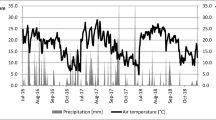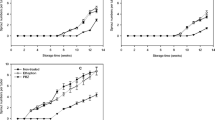Abstract
Potato microtubers were treated with rindite to investigate the effect on dormancy breaking. Postharvest application of rindite by fumigation with 2 ml rindite for 48 hr or 4ml for 24 hr significantly reduced the dormancy period of potato microtubers using a 32 x 15 x 17 cm tightly sealed plastic box. Approximately 2 weeks after the treatments microtubers of all cultivars, Atlantic, Superior, Lemhi Russet, Red Dale and Kennebec started to sprout. The efficiency of the treatments were the greatest for the cv. Lemhi Russet, intermediate for cv. Superior and least for cv. Red Dale. In all cultivars of potato microtubers, more decay was observed the earlier rindite treatment occurred after harvesting, therefore potato microtubers should be treated with rindite at least 2 weeks after harvest when the skin of microtubers is mature. The data indicates that the dormancy of potato microtubers with well-matured skin can be effectively broken with an optimum treatment of rindite.
Similar content being viewed by others
Literature Cited
Bailey, K.M., I.D.J. Phillips, and D. Pitt. The role of buds and gibberellin in dormancy and the mobilization of reserve materials in potato tubers. Ann. Bot 42:639—657.
Bogucki, S. and D.C. Nelson. 1980. Length of dormancy and sprouting characteristics often potato cultivars. Am Potato J 57:151–157.
Cho, J.L., W.M. Iritani, and M.W. Martin. 1983. Comparison of methods for measuring dormancy of potatoes. Am Potato J 60:169–177.
Coleman, W.K. 1983. An evaluation of bromoethane for breaking tuber dormancy inSolanum tuberosum L. Am Potato J 60:161–167.
Hendricks, S.B. and R.B. Taylorson. 1975. Breaking of seed dormancy by catalase inhibition. Proc Nat Acad Sci USA 72(1):306–309.
Van Ittersum, M.K. and K. Scholte. 1993. Shortening dormancy of seed potatoes by a haulm application of gibberellic acid and storage temperature regimes. Am Potato J 70:7–19.
Kim, S.Y., J.C. Jeong, J.K Kim, and M.S. Lim,. 1996. Effect of chemical treatments for the dormancy breaking of in vitro microtubers ofSolanum tuberosum L. cv. Dejima. J Kor Soc Hort Sci 37(1): 19–23.
Leclerc, Y., A.J. Donnelly, W.K Coleman, and R.R. King. 1995. Microtuber dormancy in three potato cultivars. Am Potato J 72:215–223.
McDonald, J.G. and W.K Coleman. 1988. A reevaluation of bromoethane in comparison to rindite for the post-harvest detection of potato virus Y in tubers by ELISA. Am Potato J 65:547–550.
Meijers, C.P. 1972. Effect of carbon-disulphide on the dormancy and sprouting of seed-potatoes. Potato Res 15:160–165.
Author information
Authors and Affiliations
Corresponding author
Rights and permissions
About this article
Cite this article
Kim, H.S., Jeon, J.H., Choi, K.H. et al. Effects of rindite on breaking dormancy of potato microtubers. Am. J. Pot Res 76, 5–8 (1999). https://doi.org/10.1007/BF02853551
Accepted:
Issue Date:
DOI: https://doi.org/10.1007/BF02853551




